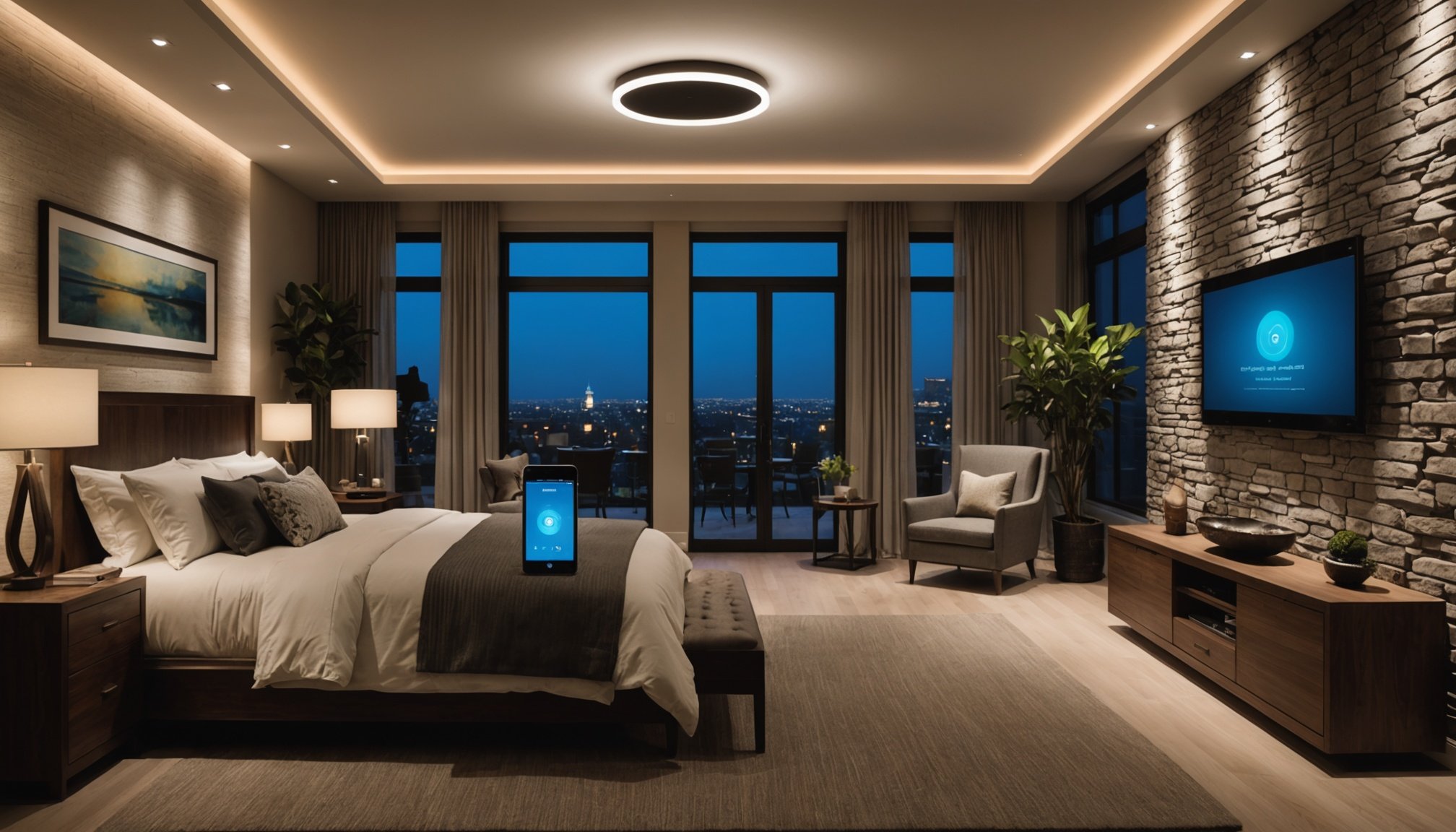Ultimate Smart Home Lighting: The Definitive Guide to Voice-Controlled Illumination Management
In the era of smart homes, managing your lighting has never been more convenient, efficient, and fun. With the advent of voice-controlled lighting systems, you can transform your home into a seamless and automated haven. Here’s a comprehensive guide to help you navigate the world of smart home lighting and make the most out of voice control.
Understanding Smart Home Lighting
Smart home lighting is more than just turning lights on and off; it’s about creating an ambiance, enhancing security, and optimizing energy consumption. Here are some key benefits of smart lighting:
Also read : Transforming Smartwatch Fitness Tracking: Innovative Techniques for Unmatched Precision
Energy Efficiency
Smart lighting systems, such as those integrated with Philips Hue or other compatible bulbs, can significantly reduce energy consumption. These systems can adjust lighting levels based on the time of day, your presence, and even the weather. For instance, “Philips Hue bulbs can be programmed to dim or turn off when you leave the room or when the sun rises, ensuring you use energy only when necessary”[1].
Enhanced Security
Smart lights can also play a crucial role in home security. By automating lighting patterns, you can make it look like someone is home even when you’re away. This can be achieved through voice commands using assistants like Amazon Alexa or Google Assistant. For example, “You can set up a routine with Alexa to turn on lights at specific times, giving the illusion of occupancy”[4].
Also to discover : Ultimate Guide to Smartphone Security: Top Strategies to Protect Your Online Shopping
Ambient Control
Voice control allows you to set the perfect ambiance for any occasion. Whether you’re watching a movie, hosting a dinner party, or just relaxing, smart lights can be adjusted to match your mood. “With a simple voice command like ‘Alexa, turn on movie mode,’ you can dim the lights and set the scene for an immersive viewing experience”[4].
Choosing the Right Voice Assistant
When it comes to voice-controlled smart home lighting, the choice of voice assistant is crucial. Here are the main players and their unique features:
Amazon Alexa
Amazon Alexa is one of the most popular voice assistants for smart home integration. It works seamlessly with a wide range of devices, including Philips Hue lights. “The Echo Show 10, with its rotating screen, is particularly useful for controlling lights and other smart devices while following recipes or watching videos”[4].
Google Assistant
Google Assistant, integrated into devices like Google Home and Nest Hub, offers robust smart home control. It can be used to control lights, thermostats, and security cameras with ease. “Google Assistant can stream live feeds from security cameras directly to your smart display, enhancing your home’s security and surveillance capabilities”[2].
Apple Siri
While Apple’s HomeKit has its limitations, especially with certain devices like Philips Hue Secure cameras, Siri still offers a streamlined experience for those deeply invested in the Apple ecosystem. However, it’s worth noting that “Philips Hue has announced it will not support Apple HomeKit via HomeKit until a camera option is integrated into the Matter standard”[2].
Setting Up Your Smart Lighting System
Setting up a smart lighting system is easier than you think. Here’s a step-by-step guide to get you started:
Step 1: Choose Your Smart Bulbs
Select smart bulbs that are compatible with your chosen voice assistant. Philips Hue, LIFX, and Belkin Wemo are popular options.
Step 2: Install the Hub
Most smart lighting systems require a hub to connect your bulbs to the internet. For Philips Hue, this is the Hue Bridge.
Step 3: Connect Your Devices
Use the app associated with your voice assistant (e.g., Amazon Alexa app, Google Home app) to connect your smart bulbs to the hub and integrate them into your smart home system.
Step 4: Configure Voice Commands
Set up voice commands and routines to control your lights. For example, you can create a routine with Alexa to turn on all the lights in your living room with a single command.
Advanced Features and Integrations
Smart lighting systems offer a plethora of advanced features that can enhance your home’s functionality and security.
Automation and Scenes
You can automate lighting based on various scenarios:
- Welcome Home: Lights turn on as you enter the house.
- Goodnight: Lights dim or turn off when you go to bed.
- Movie Night: Lights adjust to a dim, cozy setting.
Here’s an example of how you can set up automation using voice commands:
- "Alexa, turn on movie mode" to dim the lights and adjust the color temperature.
- "Google Assistant, turn off all lights" to ensure energy efficiency when leaving the house.
Security Integrations
Smart lights can be integrated with security systems to enhance home security:
- Motion Detection: Lights turn on when motion is detected, acting as a deterrent.
- Alerts: Receive notifications when unusual activity is detected.
For instance, “You can set up your smart lights to turn on automatically when your security camera detects motion, providing an additional layer of security”[3].
Voice-Controlled Devices Compatibility
Here is a table comparing the compatibility of different voice assistants with popular smart lighting devices:
| Voice Assistant | Philips Hue | LIFX | Belkin Wemo |
|---|---|---|---|
| Amazon Alexa | Yes | Yes | Yes |
| Google Assistant | Yes | Yes | Yes |
| Apple Siri | Limited | Yes | Yes |
Practical Tips and Tricks
Here are some practical tips to make the most out of your smart lighting system:
Use Voice Commands Creatively
- Custom Routines: Create custom routines that fit your lifestyle. For example, “Alexa, good morning” could turn on the lights, adjust the thermostat, and start your favorite music.
- Smart Groups: Group lights by room or area to control them collectively. “Google Assistant, turn on living room lights” can turn on all the lights in that room.
Optimize Energy Consumption
- Schedule Lighting: Use the app to schedule lighting adjustments based on your daily routine.
- Automate Dimming: Set lights to dim automatically when not in use or when natural light is sufficient.
Enhance Home Security
- Simulate Occupancy: Use voice commands to turn lights on and off randomly when you’re away to simulate occupancy.
- Integrate with Security Cameras: Use voice commands to view live feeds from security cameras on your smart display.
Real-Life Examples and Anecdotes
Here are a few real-life examples of how smart lighting can make a difference:
Convenience in Daily Life
“I use Alexa to control my lights every day. Whether I’m cooking in the kitchen and need more light or I’m watching a movie and want to set the mood, it’s all just a voice command away. It’s amazing how much it has simplified my daily routine,” says a smart home enthusiast.
Enhanced Security
“I was away on vacation and received a notification from my security camera that motion was detected. I immediately used Google Assistant to turn on all the lights in my house and view the live feed. It gave me peace of mind knowing I could monitor my home remotely,” shares another user.
Smart home lighting is no longer just a luxury; it’s a necessity for anyone looking to enhance their home’s comfort, security, and energy efficiency. With voice-controlled systems, you can manage your lights effortlessly, creating a seamless and automated living experience.
As you embark on this journey, remember to choose the right voice assistant, set up your system thoughtfully, and explore the advanced features that make smart lighting so powerful. Whether you’re using Amazon Alexa, Google Assistant, or another platform, the key is to make sure your smart home lighting system is tailored to your needs and lifestyle.
So, what are you waiting for? Dive into the world of smart home lighting and experience the convenience, security, and ambiance it has to offer. Your home will thank you.
Visual Aids and FAQs
Smart lighting systems can seem daunting, but visual guides simplify understanding and installation. Diagrams and step-by-step visuals are invaluable tools for setting up smart home lighting, showcasing how components like LED smart bulbs integrate into wireless control systems. They illustrate connections between different smart home ecosystems, ensuring seamless integration.
Frequently Asked Questions (FAQs) revolve around user experiences with voice-controlled lighting. One common question is, “How do I reset my smart bulb?” Typically, the answer involves a specific sequence of turning the light on and off, as per manufacturer guidelines. Another frequent inquiry might be, “Why is my smart light unresponsive?” Solutions often include checking Wi-Fi connectivity and ensuring all software is updated.
Visual aids are not just about installation; they also assist in troubleshooting common issues. Such guides can illuminate solutions for tackling connectivity problems, software glitches, and compatibility verifications for diverse systems like Amazon Alexa or Google Home.
To wrap it all up, using visual guides and addressing FAQs can significantly enhance user interaction with smart lighting systems, making the journey from installation, troubleshooting, to daily use straightforward and intuitive.










